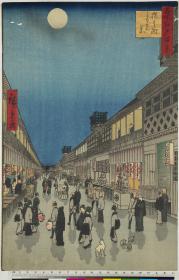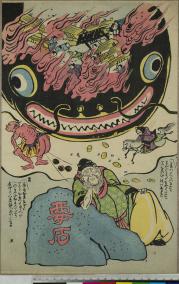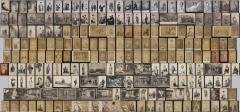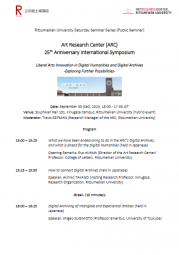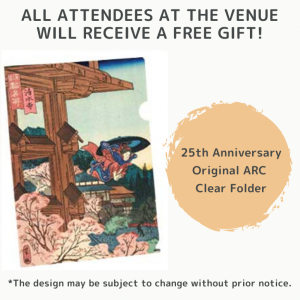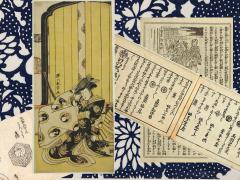-
[イベント情報]October 27, 2023(Fri)
Related article → The Royal Ontario Museum (ROM) Collection of Ukiyo-e Prints and Japanese Old Books has been released
Related databases → Royal Ontario Museum Ukiyo-e Database / Royal Ontario Museum Japanese Old Books Database
Background:
Dr. Akiko Takesue joined the Royal Ontario Museum (ROM) in 2021 as the Bishop White Committee Associate Curator of Japanese Art & Culture, an endowed position, and is in charge of researching and developing the ROM's collection of Japanese art and culture that comprises approximately 10,000 objects.
Dr. Takesue holds a doctorate in Art History from York University and Master's degrees from the University of Toronto and the University of New South Wales. In addition to the ROM, she has broad curatorial experience at the Montreal Museum of Fine Arts, the National Gallery of Art in Washington, DC, and the Art Gallery of New South Wales in Sydney, Australia.Dr Takesue, thank you very much for your time today. What sparked your interest in Japanese art history?
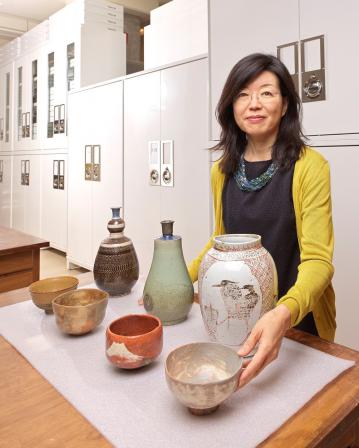 Takesue: It is a long story since I left Japan almost 25 years ago. When I was younger and living in Japan, I was more interested in Western than Japanese art. Hence, I went to Sydney, Australia, to study art. At that time, I had the idea to work in an art gallery dealing with Western contemporary art.
Takesue: It is a long story since I left Japan almost 25 years ago. When I was younger and living in Japan, I was more interested in Western than Japanese art. Hence, I went to Sydney, Australia, to study art. At that time, I had the idea to work in an art gallery dealing with Western contemporary art.Then, while I was doing an internship at the Art Gallery of New South Wales in Sydney under a Japanese curator, I discovered the beauty and excitement of studying and dealing with Japanese art. Interestingly, I realized the Japanese art collection there was different from what I thought of Japanese art, which was sort of a trigger for me to research the global circulation of Japanese art since the Meiji period.
As the Japanese collections overseas consist of many export arts, i.e., made in Japan but only for the Western market, I discovered many things I never knew about when I was in Japan. So, I became fascinated with the fact that Japanese art in Sydney was indeed different from my understanding of Japanese art. This interest continues even now.
I also investigated in my PhD dissertation how objects stay the same while their meanings shift from time to time, place to place.
How did you first connect with the Art Research Center (ARC)?
Takesue: It was through my predecessor, Dr. Rosina Buckland, who is now at the British Museum. In 2020, she started the digitization project of the ROM's Japanese art collection with Prof. Akama whom I met when he and his team was taking photographs of the collection. So, after Dr. Buckland left in 2021, I continued to complete this project, and I feel fortunate and grateful that she started it.
Comprising approximately 10,000 objects, the Japanese art collection of the ROM is the largest of its kind in Canada. Considered to be particularly comprehensive is the ukiyo-e print collection. What do you find fascinating about it and why?
Takesue: Over 2,000 ukiyo-e prints and surimono of Sir Byron Edmund Walker, one of the founders and the first chairman of the ROM, were bequested to the ROM in 1926, which became the core of our entire Japanese print collection.
The ROM already had some woodblock prints since 1916, but at that time, no one knew much about Japanese art at the museum. With the Walker Collection and the earlier prints, our print collection expanded, comprising over 4,000 prints today.
Furthermore, there is a variety in the genres of the prints. The ROM's collection consists of actor prints, prints of beautiful women, landscape prints, including those of Hokusai and Hiroshige, as well as prints from the Meiji period and war prints. So not only the sheer number of prints but the range of subjects make our collection quite valuable and unique.
For example, we have an almost complete set of Hiroshige's Meisho Edo Hyakkei (One Hundred Famous Views of Edo). It may not be well-known, but our set is almost like a 'first edition'. 'First edition' may be a tricky term, but our set is in a very good condition, and you can see the highly skilled printing techniques used. While everyone knows about the first edition at the Brooklyn Museum, hardly anybody knows about our set.
When I recently went to the Brooklyn Museum, I compared their set with printouts of some of our prints with the curator there, and we realized that both of our sets are almost identical. So, I was glad I could confirm that our set is also a high-quality series.
You also have a rare collection of Ogata Gekko prints. What are your thoughts on this collection?
Takesue: This collection is very unique, too. Although Gekko was quite well-known in his lifetime in the Meiji period and produced many prints, paintings, and book illustrations, he became somewhat of a forgotten artist.
A Toronto-based collector and former law librarian of York University, Balfour Halévy, accumulated over 600 of Gekko's works and donated the whole collection to the ROM in 2016. According to him, another extensive collection of Gekko prints exists in New Zealand. Since these two collections seem to be the only comprehensive collections dedicated to Gekko outside of Japan, we are very fortunate to have one of them at the ROM.
In June this year, 4,233 ukiyo-e prints and 74 old Japanese books from the ROM's collection were released in the ARC portal database. What is the significance of this database?
Takesue: The contents and quality of our print collection are good, however, not many people, including researchers, seem to be aware that we have such a comprehensive collection of prints. So, we are grateful for this ARC digitization project to make our collection available to researchers and the public for their studies, research, and pleasure. Otherwise, those prints remain just hidden in our storage. Except for a few notable research efforts, the whole collection has not been studied extensively.
Our goal is that many scholars and researchers will take note of the prints in the ROM's collection so we can contribute to the development of ukiyo-e research. The release of our collection marks a significant starting point.
What are your thoughts on the importance of digitization for museums, and how does it play a part in your plans at the ROM?
Takesue: Digitization of the collection is crucial to provide the public access to what we have. The ROM is a huge museum with 13 million objects in total in its collections. So, I believe that anyone can find at least one favorite object.
We try to exhibit as many in the museum as possible, but space is limited. Only less than 5% of our collection is publicly displayed. The rest is in our storage, with many objects never being on public view.
While, as a museum curator, I believe in the power of objects when you see them with your eyes, if a collection is available online, people have another way to enjoy the collection. Availability and accessibility are crucial particularly since we have no permanent Japanese gallery at the ROM right now.
I have recently completed an online exhibition on catfish prints. COVID has, in a way, accelerated the development of virtual channels. Digitization has become essential to showcase the Japanese collection at the ROM.
Finally, could you share a few of your personal favorites within the ROM's ukiyo-e print collection?
Takesue: I like ukiyo-e prints with some layers of meaning behind them, for instance, parodies (mitate-e) or complex ideas, which I realized when I did the online exhibition on the catfish prints. They are not just funny prints but encompass emotions and thoughts of people about society at that time. This is why I am fascinated with this kind of print.
Hiroshige's Meisho Edo Hyakkei (One Hundred Famous Views of Edo) is also one of my favorites, mainly because of its composition. Hiroshige uses very striking, innovative perspectives of having something huge at the front with other elements kept smaller at the back, which, at that time, was quite innovative and a reason why Western artists, including Impressionist artists were so fascinated with the Japanese prints.
Images credit: Courtesy of ROM (Royal Ontario Museum), Toronto, Canada. ©ROM
(This interview was conducted by Yinzi Emily Li)
Related article → The Royal Ontario Museum (ROM) Collection of Ukiyo-e Prints and Japanese Old Books has been released
Related databases → Royal Ontario Museum Ukiyo-e Database / Royal Ontario Museum Japanese Old Books Database
[イベント情報]October 18, 2023(Wed)The 124th International ARC Seminar will be held as a webinar on Wednesday, October 18, from 18:00 JST.
The program is as follows:
Speaker: Her Imperial Highness Princess Akiko of Mikasa
Topic: Prince Mikasa and his times
Date: Wednesday, October 18, 18:00 - 19:30 JST
Participation: Those concerned will be informed separately by e-mail.
[イベント情報]October 17, 2023(Tue)On October 17, 2023, the Tokyo Shimbun featured the article "デジタル化で今よみがえる往年の歌舞伎ブロマイド" on the Kabuki bromides in the collection of the Shochiku Otani Library which have been released in the ARC Shochiku Otani Library Theater Photos Search and Browsing System.
Digital Archive of Shochiku Otani Library's Collection of Valuable Materials "Theater Photos Search and Browsing System"
■ URL:https://www.dh-jac.net/db/butai-photo/search_sol.phpRelated article>>https://www.arc.ritsumei.ac.jp/e/news/pc/019324.html
[イベント情報]October 17, 2023(Tue)As part of the FY 2023 ARC-iJAC project 演劇上演記録データベースを活用した、演劇資料画像検索閲覧システムの構築に関る研究 (A Study on the Construction of a Search and Browsing System for Theater Photo Materials using a Database of Theater Performance Records), the Shochiku Otani Library has released a digital archive of Kabuki bromides (photographic portraits of Kabuki actors) from the Meiji era to the prewar period. Online public access to this archive is provided by the Art Research Center (ARC), Ritsumeikan University.
The Shochiku Otani Library undertook a crowdfunding project in 2019 to raise funds for the digital photography and preservation of 12,000 Kabuki bromides.
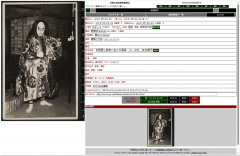
Since launching the project, the construction of the digital archive, data entry, and other preparations for web release have progressed, and we are pleased to announce that a portion of the archive has now been made available to the public through the "Theater Photos Search and Browsing System" developed by the ARC-iJAC.
With this online release, users are able to search and view Kabuki stage photographs from the Meiji era to the prewar period, as well as photographs of famous actors of the past in costume. We hope that along with a greater number of people being able to make use of the Shochiku Otani Library Collection, greater contributions to the study of Japanese theater will be possible. We humbly ask your cooperation in sharing the announcement of this release.
Digital Archive of Shochiku Otani Library's Collection of Valuable Materials "Theater Photos Search and Browsing System"
■ URL: https://www.dh-jac.net/db/butai-photo/search_sol.php
Since 2013, the Shochiku Otani Library has been engaged in crowdfunding projects to digitize and preserve valuable materials and has achieved continued results every year.
The Shochiku Otani Library and the ARC have been working together on the construction of the digital archive and to make it available to the public through an online browsing system by preparing the input of bibliographic data (titles, dates of performances, names of theaters, names of roles and actors), and other information. Approximately 5,500 of 12,000 items in the digital archive have now been released as of October 17, 2023.
The Theater Photos Search and Browsing System allows users to search for photographs based on the program name or actor name. Clicking on a thumbnail image in the search results will open an information screen that displays detailed information such as program name, role, and actor name, as well as an enlarged image.
We hope that the release of the digital archive of Kabuki bromides--valuable materials that record Kabuki performances and famous actors of the time--will enable users to experience the appeal of Kabuki and contribute to the development of research by scholars and those associated with the theatre.
We will continue to investigate and verify the data to improve the digital archive beyond its release.
[イベント情報]October 15, 2023(Sun)On October 15, 2023, the Nihon Keizai Shimbun (Nikkei) featured the second part of a coverage on the research projects to digitize overseas museum collections, led by Prof. Ryo Akama, Director of the Art Research Center (ARC).
[イベント情報]October 11, 2023(Wed)The 123rd International ARC Seminar will be held as a webinar on Wednesday, October 11, from 18:00 JST.
The program is as follows:
Speaker: Toshiyasu KAMOGI (Curator & Manager of Curatorial Div., Tokyo Fuji Art Museum)
Topic: The Achievements and Future Outlook of a Homemade Database by a Liberal Arts Computer Enthusiast Curator--From the Frontline of Digital Archive Operation for Streamlining and Enhancing Museum Curatorial Services--
Date: Wednesday, October 11, 18:00 - 19:30 JST
Participation: online via Zoom, free of charge (no reservation required)
*This webinar is open to everyone, and non-ARC members are also invited to participate via YouTube.
[イベント情報]October 8, 2023(Sun)On October 8, 2023, the Nihon Keizai Shimbun (Nikkei) featured the first part of a coverage on the research projects to digitize overseas museum collections, led by Prof. Ryo Akama, Director of the Art Research Center (ARC).
[イベント情報]October 5, 2023(Thu)
25th Anniversary International Symposium
To commemorate the 25th anniversary of its establishment in 1998, the Art Research Center (ARC), Ritsumeikan University, held an international symposium on September 30, 2023 under the theme Liberal Arts Innovation in Digital Humanities and Digital Archives--Exploring Further Possibilities. The event was held in a hybrid format.
Event Overview:
The Art Research Center (ARC), Ritsumeikan University, is marking the 25th anniversary of its establishment in 2023. As a center of arts and culture research at Ritsumeikan University in the academic metropolis of Kyoto, the ARC has since its establishment pursued new research utilizing digital technologies. This kind of research based on digital technology research methods came to be called Digital Humanities (DH) and has attracted attention as the most advanced field in humanities research. As a result, the role of the ARC continues to grow in importance, and the Center has gained traction as a driving force in Digital Humanities both in Japan and overseas.
Further, the digital environment, the foundation of Digital Humanities, is built on digital archives. Designated by the Ministry of Education, Culture, Sports, Science and Technology (MEXT) as an International Joint Usage / Research Center, the ARC has taken on many research projects from abroad in its capacity as the International Joint Digital Archiving Center for Japanese Art & Culture (ARC-iJAC), thus strengthening its research activities.
The digital archives, in which the ARC has accumulated research focusing on Japanese traditional culture over the past 25 years, have been interlinked with the open archives of other institutions and continue to form part of the big data of Japanese cultural resources. Furthermore, as seen in the rapid spread of the Metaverse and Generative AI research, in the current present in which humans are beginning to open up digital space as another area for engagement, this kind of big data of cultural resources is not only expected to become a source for specialist academic research but also a digital resource common to all humankind that shall be more open for social use.
The horizons of digital humanities, opened up by digital archives, bring new societal reforms and expansions that should be called "public humanities". On the occasion of this 25th anniversary, we are holding a commemorative international symposium: inviting guests who have provided valuable advice for the Center's activities to discuss the Center's achievements and future direction while further promoting cooperation with related institutions and researchers in Japan and abroad.
Speakers:
Ryo AKAMA (Professor, College of Letters, Ritsumeikan University/Director of the ARC)
Akihiko TAKANO (Visiting Research Professor, Kinugasa Research Organization, Ritsumeikan University)
Shigeo SUGIMOTO(Professor Emeritus, University of Tsukuba)
Graeme EARL(Professor & Head of College, SOAS University of London)
Koichi HOSOI (Professor, College of Image Arts and Sciences, Ritsumeikan University/Deputy Director of the ARC)
【Moderator】Travis Seifman(Research Manager of the ARC, Ritsumeikan University)
>>Website of the Ritsumeikan University Saturday Seminar Series
[イベント情報]September 30, 2023(Sat)
25th Anniversary International Symposium
To commemorate the 25th anniversary of its establishment in 1998, the Art Research Center (ARC), Ritsumeikan University, will hold an international symposium.
Date: September 30 (Sat), 2023, 15:00 - 17:30 JST
Hybrid event (Soushikan Hall 101, Kinugasa Campus & online)Speakers:
Ryo AKAMA (Professor, College of Letters, Ritsumeikan University/Director of the ARC)
Akihiko TAKANO (Visiting Research Professor, Kinugasa Research Organization, Ritsumeikan University)
Shigeo SUGIMOTO(Professor Emeritus, University of Tsukuba)
Graeme EARL(Professor & Head of College, SOAS University of London)
Koichi HOSOI (Professor, College of Image Arts and Sciences, Ritsumeikan University/Deputy Director of the ARC)
【Moderator】Travis Seifman(Research Manager of the ARC, Ritsumeikan University)Participation is free of charge・Advance registration required (max. 400)
As the Art Research Center (ARC) celebrates its 25th anniversary in 2023, we sincerely thank you for your continued support. As a token of our appreciation, we have prepared a free gift for all those who attend the symposium at the venue.
Event Overview:
The Art Research Center (ARC), Ritsumeikan University, is marking the 25th anniversary of its establishment in 2023. As a center of arts and culture research at Ritsumeikan University in the academic metropolis of Kyoto, the ARC has pursued new research utilizing digital technologies since its establishment. This kind of research based on digital technology research methods came to be called Digital Humanities (DH) and has attracted attention as the most advanced field in humanities research. As a result, the role of the ARC continues to grow in importance, and the Center has gained traction as a driving force in Digital Humanities both in Japan and overseas.
Further, the digital environment, the foundation of Digital Humanities, is built on digital archives. Designated by the Ministry of Education, Culture, Sports, Science and Technology (MEXT) as an International Joint Usage / Research Center, the ARC has taken on many research projects from abroad in its capacity as the International Joint Digital Archiving Center for Japanese Art & Culture (ARC-iJAC), thus strengthening its research activities.
The digital archives, in which the ARC has accumulated research focusing on Japanese traditional culture over the past 25 years, have been interlinked with the open archives of other institutions and continue to form part of the "big data" of Japanese cultural resources. Furthermore, as seen in the rapid spread of the Metaverse and Generative AI research, in the current present in which humans are beginning to open up digital space as another area for engagement, this kind of big data of cultural resources is not only expected to become a source for specialist academic research but also a digital resource common to all humankind that shall be more open for social use.
The horizons of digital humanities, opened up by digital archives, bring new societal reforms and expansions that should be called "public humanities". On the occasion of this 25th anniversary, we are holding a commemorative international symposium: inviting guests who have provided valuable advice for the Center's activities to discuss the Center's achievements and future direction while further promoting cooperation with related institutions and researchers in Japan and abroad.
>>Website of the Ritsumeikan University Saturday Seminar Series
[イベント情報]September 20, 2023(Wed)Co-organized by the Center for Japanese Studies (CJS), University of California, Berkeley, and the Art Research Center (ARC), Ritsumeikan University, a joint colloquium was held at Dwinelle Hall, University of California, Berkeley on September 15, 2023.
Under the theme Theory and Methods in the Japanese Humanities: Research Using Visual Sources and Archives, faculty and graduate students from the Center for Japanese Studies (CJS) and the Art Research Center (ARC) delivered presentations on the use of visual sources and archives in their research. While discussing the specific content of their respective research projects, the presenters discussed and exchanged research methods, approaches, and techniques for employing visual sources and archives.
Theme: Theory and Methods in the Japanese Humanities: Research Using Visual Sources and Archives
Date: September 15 (Fri), 16:00-18:00 PDT / September 16 (Sat), 8:00-10:00 JST
Venue: Rm 370, Dwinelle Hall, University of California, Berkeley + online via ZOOM (※This was a non-public event.)
Program
16:00 - 16:05 Opening remarks by Prof. Jonathan E. ZWICKER (Center for Japanese Studies, Dept. of East Asian Languages and Cultures, University of California, Berkeley)
16:05 - 16:25 The Value of Visual Sources in Digital Archives for Researching the Ryukyu Kingdom's Embassies to Edo (held in English)
Speaker: Dr. Travis SEIFMAN (Kinugasa Research Organization, Ritsumeikan University/Research Manager of the ARC)
16:25 - 16:40 The Utility of Digital Archives in Kabuki Research: Focusing on an Approach Using Actor's Prints from the Mid-Edo Period (held in English)
Speaker: Shiori TOTSUKA (PhD Student, Graduate School of Letters, Ritsumeikan University)
16:40 - 16:55 An Attempt to Construct a Design Encyclopedia Using Digital Archives (held in English)
Speaker: Risako HIRANO (PhD Student, Graduate School of Letters, Ritsumeikan University)
-Break (5 minutes)-
17:00 - 17:15 The Comedy of Inoue Hisashi and the Critique of Modern Japan (held in English)
Speaker: Megumi HIROTA (MA Student in Asian Studies, University of California, Berkeley)
17:15 - 17:30 帝国日本の銃後の主体性 (Agency) -1943年の一枚のプロパガンダ小説、辻小説を中心に- (held in Japanese)
Speaker: Hong JANG (PhD Student in East Asian Languages and Cultures, University of California, Berkeley)
17:30 - 17:45 Archival Hesitancies: Problems of Research as Method (held in English)
Speaker: Frank CAHILL (PhD Student in Comparative Literature, University of California, Berkeley)
17:45 - 17:55 Discussion
17:55 - 18:00 Closing remarks by
18:00 ~ Reception
This colloquium was supported by the International Joint Digital Archiving Center for Japanese Art and Culture (ARC-iJAC), Art Research Center, Ritsumeikan University.


